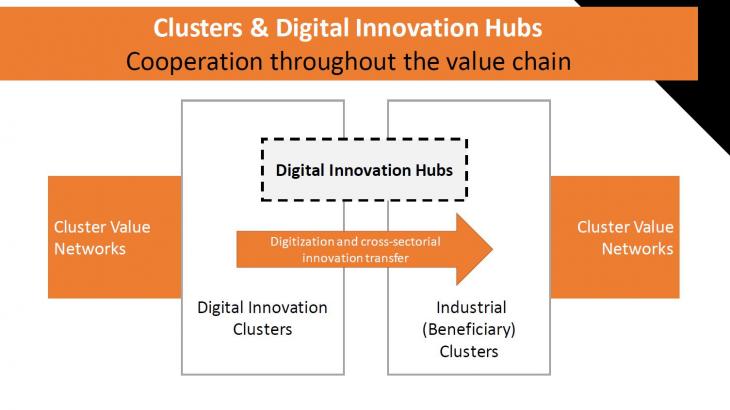Clusters’ role on Digital Innovation Hubs
Summary of the European Alliance Against Coronavirus Daily Webinar on 14 July 2020.
This morning session was dedicated to the role that clusters have in relation with Digital Innovation Hubs. Contrary to popular conceptions, clusters and Digital Innovation Hubs do not need to be competitors, as they fulfill different functions. The three experts in this session underlined that they should be collaborators to create the best possible environment for the companies.
Anne-Marie Sassen from DG CNECT shared with the group the objectives of the European Commission to develop a new industrial strategy for SMEs. The main idea is to help companies in the digital and green transition and improve their global competitiveness, without leaving anyone excluded. Digital Innovation Hubs (DIH) can play an important role through the support dedicate to the local businesses. The plan is to build a network of 240 DIH which will work closely with the EEN, clusters, other networks, and authorities. These European Digital Innovation Hubs (EDIH) provide technological expertise and experimentation facilities to enable the digital transformation of the industry and the public sector with the collaboration of different stakeholders. The network is the key to develop EDIH with an “EU-local” approach in order to put companies in contact with the competence they need in EU.
Bianca Muntean from Transilvania DIH shared the history of DIH that made the first steps in 2017 and saw the development of the EDIH for the North West region in 2020, after a series of European awards and projects. The governance of Transylvania DIH involves 4 clusters, which differ by specialization but were able to develop a strong cohesion and collaboration through the creation of networks. The Transilvania DIH approach is a cross-sectoral with the aim to give complete services to the companies in order to increase the market and industrial value stream. Global competitiveness and digitalization are key factors, working always very close to the clusters. She highlighted that every region has its own specific assets, which are buildings blocks for the DIHs.
Kristina Šermukšnytė-Alešiūnienė from Agrifood Lithuania DIH/Smart IT cluster emphazised in her speech that cluster and DIH are not two entities in competition with each other. They are instead two realities that can dialogue and collaborate without losing their nature. They can cooperate through the value chain with a cross-sectoral approach for innovation transfer and digitalization to create multiplicative effects. An example of this type of collaboration is the AgriFood Lithuania DIH, which includes both concepts in their entity.
These are the complete minutes of the meeting:
20200714 ECA dailyminutes_v2.pdfThese are the presentations from the meeting:
Intro DIH Cluster meeting.pdf Role clusters DIH AgriFood Lithuania.pdf Versiunea Noua_Transilvania DIH_EN.pdfFind information on the previous meetings here; information on the upcoming agenda here.
